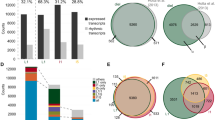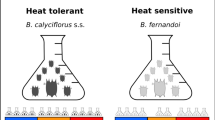Abstract
As most organisms have evolved in seasonal environments, their environmental responses should be adapted to seasonal transitions. Here we show that the combination of temperature and day length shapes the seasonal dynamics of the transcriptome and adaptation to seasonal environments in a natural habitat of a perennial plant Arabidopsis halleri subsp. gemmifera. Weekly transcriptomes for two years and bihourly diurnal transcriptomes on the four equinoxes/solstices, identified 2,879 and 7,185 seasonally- and diurnally-oscillating genes, respectively. Dominance of annual temperature changes for defining seasonal oscillations of gene expressions was indicated by controlled environment experiments manipulating the natural 1.5-month lag of temperature behind day length. We found that plants have higher fitness in ‘natural’ chambers than in ‘unnatural’ chambers simulating in-phase and anti-phase oscillations between temperature and day length. Seasonal temperature responses were disturbed in unnatural chambers. Our results demonstrate how plants use multiple types of environmental information to adapt to seasonal environments.
This is a preview of subscription content, access via your institution
Access options
Access Nature and 54 other Nature Portfolio journals
Get Nature+, our best-value online-access subscription
$29.99 / 30 days
cancel any time
Subscribe to this journal
Receive 12 digital issues and online access to articles
$119.00 per year
only $9.92 per issue
Buy this article
- Purchase on Springer Link
- Instant access to full article PDF
Prices may be subject to local taxes which are calculated during checkout






Similar content being viewed by others
Data availability
The sequence data that support the findings of this study are available in the DDBJ Short Read Archive repository, with the accession numbers DRA005871, DRA005872, DRA005873, DRA005874, DRA005875 and DRA005876. Database of detailed results of individual genes is at http://sohi.ecology.kyoto-u.ac.jp/AhgRNAseq/.
Change history
08 February 2019
In Fig. 3b of the version of this Article originally published, a number of arrows indicating repression of downstream processes were mistakenly formatted as arrows indicating activation of downstream processes. This has now been amended in all versions of the Article.
References
Kudoh, H. Molecular phenology in plants: In natura systems biology for the comprehensive understanding of seasonal responses under natural environments. New Phytol. 210, 399–412 (2016).
Elzinga, J. A. et al. Time after time: flowering phenology and biotic interactions. Trends Ecol. Evol. 22, 432–439 (2007).
Penfield, S. & MacGregor, D. R. Effects of environmental variation during seed production on seed dormancy and germination. J. Exp. Bot. 68, 819–825 (2016).
Hepworth, J. & Dean, C. Flowering Locus C’s lessons: conserved chromatin switches underpinning developmental timing and adaptation. Plant Physiol. 168, 1237–1245 (2015).
Polgar, C. A. & Primack, R. B. Leaf-out phenology of temperate woody plants: from trees to ecosystems. New Phytol. 191, 926–941 (2011).
Keskitalo, J. A cellular timetable of autumn senescence. Plant Physiol. 139, 1635–1648 (2005).
Chaiwanon, J., Wang, W., Zhu, J. Y., Oh, E. & Wang, Z. Y. Information integration and communication in plant growth regulation. Cell 164, 1257–1268 (2016).
Aikawa, S., Kobayashi, M. J., Satake, A., Shimizu, K. K. & Kudoh, H. Robust control of the seasonal expression of the Arabidopsis FLC gene in a fluctuating environment. Proc. Natl Acad. Sci. USA 107, 11632–11637 (2010).
Satake, A. et al. Forecasting flowering phenology under climate warming by modelling the regulatory dynamics of flowering-time genes. Nat. Commun. 4,2303 (2013).
Nagano, A. J. et al. Deciphering and prediction of transcriptome dynamics under fluctuating field conditions. Cell 151, 1358–1369 (2012).
Plessis, A. et al. Multiple abiotic stimuli are integrated in the regulation of rice gene expression under field conditions. eLife 4, e08411 (2015).
Burow, M. & Halkier, B. A. How does a plant orchestrate defense in time and space? Using glucosinolates in Arabidopsis as case study. Curr. Opin. Plant Biol. 38, 142–147 (2017).
Stief, A. et al. Arabidopsis miR156 regulates tolerance to recurring environmental stress through SPL transcription factors. Plant Cell 26, 1792–1807 (2014).
Charng, Y. Y. et al. A heat-inducible transcription factor, HsfA2, is required for extension of acquired thermotolerance in Arabidopsis. Plant Physiol. 143, 251–262 (2006).
Lämke, J., Brzezinka, K., Altmann, S. & Bäurle, I. A hit-and-run heat shock factor governs sustained histone methylation and transcriptional stress memory. EMBO J. 35, 162–175 (2016).
Bieniawska, Z. et al. Disruption of the Arabidopsis circadian clock is responsible for extensive variation in the cold-responsive transcriptome. Plant Physiol. 147, 263–279 (2008).
Murayama, Y. et al. Low temperature nullifies the circadian clock in cyanobacteria through Hopf bifurcation. Proc. Natl Acad. Sci. USA 114, 5641–5646 (2017).
Nakamichi, N. et al. Transcript profiling of an Arabidopsis PSEUDO RESPONSE REGULATOR arrhythmic triple mutant reveals a role for the circadian clock in cold stress response. Plant Cell Physiol. 50, 447–462 (2009).
Koo, A. J. K., Chung, H. S., Kobayashi, Y. & Howe, G. A. Identification of a peroxisomal acyl-activating enzyme involved in the biosynthesis of jasmonic acid in Arabidopsis. J. Biol. Chem. 281, 33511–33520 (2006).
Bouché, F., Lobet, G., Tocquin, P. & Périlleux, C. FLOR-ID: an interactive database of flowering-time gene networks in Arabidopsis thaliana. Nucleic Acids Res. 44, D1167–D1171 (2016).
Shim, J. S., Kubota, A. & Imaizumi, T. Circadian clock and photoperiodic flowering in Arabidopsis: CONSTANS is a hub for signal integration. Plant Physiol. 173, 5–15 (2017).
Niwa, Y. et al. Genetic linkages of the circadian clock-associated genes, TOC1, CCA1 and LHY, in the photoperiodic control of flowering time in Arabidopsis thaliana. Plant Cell Physiol. 48, 925–937 (2007).
Nakamichi, N. et al. Transcriptional repressor PRR5 directly regulates clock-output pathways. Proc. Natl Acad. Sci. USA 109, 17123–17128 (2012).
Dopico, X. C. et al. Widespread seasonal gene expression reveals annual differences in human immunity and physiology. Nat. Commun. 6, 7000 (2015).
Jones, H. G. Plants and Microclimate: A Quantitative Approach to Environmental Plant Physiology 3rd edn (Cambridge Univ. Press, Cambridge, 2014).
Costa, J. M., Grant, O. M. & Chaves, M. M. Thermography to explore plant–environment interactions. J. Exp. Bot. 64, 3937–3949 (2013).
Travers, S. E. et al. Variation in gene expression of Andropogon gerardii in response to altered environmental conditions associated with climate change. J. Ecol. 98, 374–383 (2010).
Chew, Y. H. et al. Linking circadian time to growth rate quantitatively via carbon metabolism. Preprint at bioRxiv https://doi.org/10.1101/105437 (2017).
Endo, M., Shimizu, H., Nohales, M. A., Araki, T. & Kay, S. A. Tissue-specific clocks in Arabidopsis show asymmetric coupling. Nature 515, 419–422 (2014).
Gould, P. D. et al. Coordination of robust single cell rhythms in the Arabidopsis circadian clock via spatial waves of gene expression. eLife 7, e31700 (2018).
Shimizu, H. et al. Decentralized circadian clocks process thermal and photoperiodic cues in specific tissues. Nat. Plants 1, 1–6 (2015).
Dodd, A. N. et al. Plant circadian clocks increase photosynthesis, growth, survival, and competitive advantage. Science 309, 630–633 (2005).
Kidokoro, S. et al. Different cold-signalling pathways function in the responses to rapid and gradual decreases in temperature. Plant Cell 29, 760–774 (2017).
Kudoh, H., Honjo, M. N., Nishio, H. & Sugisaka, J. The long-term “in natura” study sites of Arabidopsis halleri for plant transcription and epigenetic modification analyses in natural environments. Methods Mol. Biol. 1830, 41–57 (2018).
Wang, L. et al. A low-cost library construction protocol and data analysis pipeline for illumina-based strand-specific multiplex RNA-seq. PLoS ONE 6, e26426 (2011).
Hu, T. T. et al. The Arabidopsis lyrata genome sequence and the basis of rapid genome size change. Nat. Genet. 43, 476–483 (2011).
Langmead, B. & Salzberg, S. L. Fast gapped-read alignment with Bowtie 2. Nat. Methods 9, 357–359 (2012).
Kamitani, M., Nagano, A. J., Honjo, M. N. & Kudoh, H. RNA-Seq reveals virus-virus and virus-plant interactions in nature. FEMS Microbiol. Ecol. 92, fiw176 (2016).
Li, B. & Dewey, C. N. RSEM: accurate transcript quantification from RNA-Seq data with or without a reference genome. BMC Bioinformatics 12, 323 (2011).
R Development Core Team. R: A Language and Environment for Statistical Computing (R Foundation for Statistical Computing, 2015).
Law, C. W., Chen, Y., Shi, W. & Smyth, G. K. Voom: precision weights unlock linear model analysis tools for RNA-seq read counts. Genome Biol. 15, 1–17 (2014).
Iwayama, K., Aisaka, Y., Kutsuna, N. & Nagano, A. J. FIT: statistical modeling tool for transcriptome dynamics under fluctuating field conditions. Bioinformatics 33, 1672–1680 (2017).
Benjamini, Y. & Hochberg, Y. Controlling the false discovery rate: a practical and powerful approach to multiple testing. J. R. Stat. Soc. Ser. B Stat. Methodol. 57, 289–300 (1995).
Berardini, T. Z. et al. The Arabidopsis information resource: making and mining the ‘gold standard’ annotated reference plant genome. Genesis 53, 474–485 (2015).
Acknowledgements
We thank Y. Kobayashi, K. Yoneya and Y. Sato for assistance and A. Dodd and N. Nakamichi for valuable discussion. This study was supported by JSPS Grant-in Aid for Scientific Research (S) no. 26221106 and JST CREST no. JPMJCR15O1 to H.K., and JST CREST no. JPMJCR15O2 and JSPS Grant-in Aid for Scientific Research nos. JP16H06171 and JP16H01473 to A.J.N.
Author information
Authors and Affiliations
Contributions
H.K. designed the project collaboratively with all co-authors. T.K. and J.S. conducted field experiments. J.S. and A.J.N. conducted GC experiments. M.N.H. conducted RNA-Seq experiments. A.J.N. and K.I. analysed data. A.J.N. and H.K. wrote the manuscript with input from all co-authors.
Corresponding author
Ethics declarations
Competing interests
The authors declare no competing interests.
Additional information
Publisher’s note: Springer Nature remains neutral with regard to jurisdictional claims in published maps and institutional affiliations.
Supplementary information
Supplementary Information
Supplementary Figures 1–7.
Supplementary Data
Supplementary Tables 1–9.
Rights and permissions
About this article
Cite this article
Nagano, A.J., Kawagoe, T., Sugisaka, J. et al. Annual transcriptome dynamics in natural environments reveals plant seasonal adaptation. Nature Plants 5, 74–83 (2019). https://doi.org/10.1038/s41477-018-0338-z
Received:
Accepted:
Published:
Issue Date:
DOI: https://doi.org/10.1038/s41477-018-0338-z
This article is cited by
-
Grapevine scion gene expression is driven by rootstock and environment interaction
BMC Plant Biology (2023)
-
Seasonal pigment fluctuation in diploid and polyploid Arabidopsis revealed by machine learning-based phenotyping method PlantServation
Nature Communications (2023)
-
DeLTa-Seq: direct-lysate targeted RNA-Seq from crude tissue lysate
Plant Methods (2022)
-
Genome-wide TCP transcription factors analysis provides insight into their new functions in seasonal and diurnal growth rhythm in Pinus tabuliformis
BMC Plant Biology (2022)
-
Time-series RNA-Seq transcriptome profiling reveals novel insights about cold acclimation and de-acclimation processes in an evergreen shrub of high altitude
Scientific Reports (2022)



